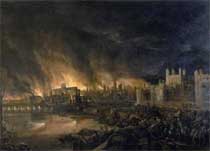Reading Comprehension - Comprensión de Lectura
Date:
 The Great Fire of London was a major conflagration that swept through the central parts of the English city of London, from Sunday, 2 September to Wednesday, 5 September 1666.
The Great Fire of London was a major conflagration that swept through the central parts of the English city of London, from Sunday, 2 September to Wednesday, 5 September 1666.
The fire gutted the medieval City of London inside the old Roman city wall. It threatened, but did not reach, the aristocratic district of Westminster, Charles II's Palace of Whitehall, and most of the suburban slums. It consumed 13,200 houses, 87 parish churches, St Paul's Cathedral and most of the buildings of the City authorities. It is estimated to have destroyed the homes of 70,000 of the City's 80,000 inhabitants.
The death toll is unknown but traditionally thought to have been small, as only six verified deaths were recorded. This reasoning has recently been challenged on the grounds that the deaths of poor and middle-class people were not recorded, while the heat of the fire may have cremated many victims leaving no recognisable remains. A melted piece of pottery on display at the Museum of London found by archaeologists in Pudding Lane, where the fire started, shows that the temperature reached 1700 °C.
The Great Fire started at the bakery of Thomas Farriner (or Farynor) on Pudding Lane, shortly after midnight on Sunday, 2 September, and spread rapidly west across the City of London. The use of the major firefighting technique of the time, the creation of firebreaks by means of demolition, was critically delayed owing to the indecisiveness of the Lord Mayor of London, Sir Thomas Bloodworth. By the time large-scale demolitions were ordered on Sunday night, the wind had already fanned the bakery fire into a firestorm which defeated such measures.
The fire pushed north on Monday into the heart of the City. Order in the streets broke down as rumours arose of suspicious foreigners setting fires. The fears of the homeless focused on the French and Dutch, England's enemies in the ongoing Second Anglo-Dutch War; these substantial immigrant groups became victims of lynchings and street violence. On Tuesday, the fire spread over most of the City, destroying St Paul's Cathedral and leaping the River Fleet to threaten Charles II's court at Whitehall, while coordinated firefighting efforts were simultaneously mobilising. The battle to quench the fire is considered to have been won by two factors: the strong east winds died down, and the Tower of London garrison used gunpowder to create effective firebreaks to halt further spread eastward.
The social and economic problems created by the disaster were overwhelming. Evacuation from London and resettlement elsewhere were strongly encouraged by Charles II, who feared a London rebellion amongst the dispossessed refugees. Despite numerous radical proposals, London was reconstructed on essentially the same street plan used before the fire.
This article is licensed under the GNU Free Documentation License. It uses material from the Wikipedia article "Great Fire of London". You can explore more on the Wikipedia website. The text and the images are used here only for educational purposes.
Questions about the text
Más ejercicios para practicar inglés
Libros recomendados (Ad)
Intermediate English Reading and Comprehension
Este libro contiene diversas lecturas con ejercicios para estudiantes de nivel intermedio. Es ideal para incorporar vocabulario, mejorar la comprensión y aprender estrategias de lectura. Ver más
Fast Forward Reading
Diseñado especialmente para estudiantes de nivel intermedio y avanzado, este libro incluye técnicas prácticas para leer más rápido, recordar más y comprender mejor cualquier texto. Ver más
English Reading: 10 Passages for English Learners
Un libro práctico con 10 lecturas para estudiantes intermedios, con ejercicios de comprensión que ayudan a prepararse para exámenes internacionales como TOEFL, TOEIC, IELTS. Ver más



Aprende nuevas palabras y expresiones idiomáticas del inglés analizando diálogos de películas en English & Movies.
Find the answers to these questions by learning more than 50 ways of walking.

Great Tales from English
History
The truth about King Arthur, Lady Godiva, Richard the Lionheart, and more!



